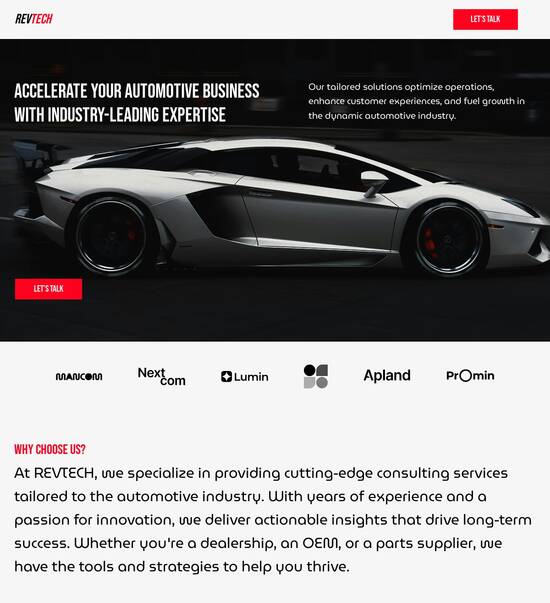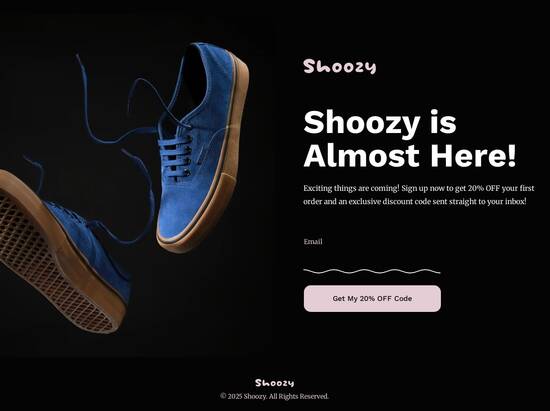
Javascript optimized cookie policy page template
Explore Similar TemplatesAbout template
Supercharge your cookie policy page with Javascript for outstanding performance! Learn more today.
Recommended templates

Easy to build without coding
With the intuitive drag-and-drop builder, anyone on your team can create high-converting pages without any knowledge of code or design. Make enhancements to your landing page with custom widgets using Javascript, HTML/CSS, or third-party scripts.

Multiple layouts for any industry and goal
Select from 500+ landing page layouts built to boost conversions across industry-specific scenarios. Customize them by adjusting fonts, adding images, and generating on-brand content with the AI assistant. Quickly scale with Instablocks® and Global Blocks that you can save, reuse, and update globally.

Loads fast and looks polished on any device
Every template is responsive, which means they present professionally on any device and load blazingly fast with our Thor Render Engine. You can also power them up with Google AMP technology to deliver an unparalleled mobile experience and drive higher conversions.

Robust analytics & experimentation
Get real-time updates and reporting across all your devices, showing the number of visitors, conversions, cost-per-visitor, and cost-per-lead. Launch AI-powered experiments, run A/B tests, and use heatmaps to analyze user behavior, then optimize your landing page to maximize conversions.







Easy to build without coding
With the intuitive drag-and-drop builder, anyone on your team can create high-converting pages without any knowledge of code or design. Make enhancements to your landing page with custom widgets using Javascript, HTML/CSS, or third-party scripts.
Multiple layouts for any industry and goal
Select from 500+ landing page layouts built to boost conversions across industry-specific scenarios. Customize them by adjusting fonts, adding images, and generating on-brand content with the AI assistant. Quickly scale with Instablocks® and Global Blocks that you can save, reuse, and update globally.
Loads fast and looks polished on any device
Every template is responsive, which means they present professionally on any device and load blazingly fast with our Thor Render Engine.
Robust analytics & experimentation
Get real-time updates and reporting across all your devices, showing the number of visitors, conversions, cost-per-visitor, and cost-per-lead. Launch AI-powered experiments, run A/B tests, and use heatmaps to analyze user behavior, then optimize your landing page to maximize conversions.
All the features you need to build lead-generating landing pages
Explore more featuresLearn how to build top-performing landing pages for any goal
FAQs
Leading the way in building high-performing landing pages





A comprehensive guide to using Instapage for landing pages and conversion rate optimization
If you're looking to maximize the effectiveness of your marketing campaigns, using Instapage's advanced landing page and CRO tools can transform your digital strategy. With various intuitive features designed for marketers across industries such as tech, education, and financial services, you can create high-converting landing pages that attract and maintain potential leads. This guide provides actionable steps to harness the full potential of Instapage to enhance your marketing efforts.
Understanding the essentials of Instapage
Instapage stands out as a powerful platform for building landing pages optimized for conversions. Here are some key features that set it apart:
- User-friendly drag-and-drop builder: Enables quick page creation without the need for coding.
- Versatile templates: Access over 100 customizable templates tailored to various industries.
- Integration capabilities: Seamlessly connects with email marketing services, CRMs, and analytics tools.
Step 1: Crafting your landing page design
The design is pivotal in capturing attention. Follow these steps to create an engaging layout:
- Choose a template: Select a layout that aligns with your campaign goals and audience expectations.
- Add compelling visuals: Include high-quality images or videos that reflect your brand and message.
- Optimize for speed: Ensure the page loads quickly to reduce bounce rates.
Step 2: Enhancing landing page performance with optimization features
Once your design is complete, focus on optimizing for conversions. Here’s how:
- A/B testing: Experiment with different headlines, visuals, and calls-to-action to discover what performs best.
- Utilize heatmaps: Gain insights into user behavior and make data-driven adjustments for improved performance.
- Set up analytics tracking: Monitor key metrics like conversion rate, bounce rate, and user engagement.
Step 3: Personalize your user experience
Creating a personalized experience can significantly increase conversion rates. Consider the following tactics:
- Dynamic text replacement: Tailor content based on the referring source or audience segment.
- AdMaps feature: Align specific ads with corresponding landing pages for increased relevance.
- Audience tracking: Use data analytics to segment audiences and adjust messaging accordingly.
Investing time into optimizing your landing pages can dramatically enhance your ROI, making Instapage a top choice for marketers aiming for efficiency and effectiveness.
Ready to elevate your marketing campaigns? Start using Instapage today to create landing pages that convert.
JavaScript optimized cookie policy page template
Understanding the essentials of a JavaScript-optimized cookie policy page template
A well-structured cookie policy is crucial for websites today, particularly concerning the regulations around user privacy. Given that cookies play a pivotal role in data collection and user experience, understanding how to optimize cookie policy pages using JavaScript is essential. This article will explore various facets of cookie policy optimization, providing insights for marketers aiming to improve compliance while also enhancing user engagement.
The importance of a cookie policy in the digital era
User consent has become a cornerstone of modern web governance, and cookie policies are central to this framework. The implementation of regulations like the General Data Protection Regulation (GDPR) and the California Consumer Privacy Act (CCPA) mandates explicit user consent before tracking their data through cookies. This has implications not just for the legal standing of websites, but also for cultivating trust and transparency with users.
Moreover, understanding various consent modes, such as opt-in, opt-out, and implicit consent, is significant for ensuring that users are aware of how their data is used. Each of these modes influences how digital services can engage their audience without violating privacy regulations. This further enhances the user experience and adherence to compliance laws.
Key components of an effective cookie policy page
Clear explanation of cookies: Differentiate between first-party and third-party cookies, along with defining essential cookies, performance cookies, functionality cookies, and targeting cookies.
User rights and obligations: Inform users of their rights under GDPR and CCPA, and clearly outline the site’s obligations regarding data collection and obtaining user consent.
Impact on ads and analytics: Discuss how cookie consent can reshape marketing strategies, maintaining compliance while still being effective in data collection.
Crafting the cookie banner: Design and compliance
Creating a cookie banner that is both compliant and user-friendly is vital. Optimizing visual impact is essential for encouraging user engagement while adhering to regulations. The design should attract attention but remain non-intrusive to the user experience. Using colors that align with your brand while ensuring readability will help in this regard.
Accessibility should also be factored in, complying with WCAG 2.2 and ADA standards. This ensures that users with disabilities can easily comprehend and navigate the cookie banner. The language used in the cookie consent message must be user-centric, informative, and persuasive to maximize acceptance rates. Avoiding technical jargon can help foster quicker comprehension among users.
JavaScript: The backbone of optimization
JavaScript plays a significant role in enhancing the functionality of cookie policy pages. By leveraging JavaScript, website owners can create dynamic banner displays based on user behavior. For example, a banner might appear differently for repeat visitors compared to first-time users, making the experience feel tailored and more engaging.
Additionally, event listeners in JavaScript can be employed to track real-time consent updates. This means that as users interact with the cookie banner, their preferences are logged, leading to a more intuitive user experience. Ensuring speed and performance is also crucial; techniques like lazy loading for cookie scripts help minimize load times, thereby enhancing the overall site performance.
Innovative features of an optimized cookie policy template
Customizable consent modes: Allow users to tailor their consent options based on specific marketing needs, providing flexibility and comfort.
Integrated analytics and reporting tools: Implement systems for monitoring user interactions with the cookie banner, using this data to refine strategies and improve the user experience.
Best practices for implementation and maintenance
Regular updates and audit trails are essential components of a robust cookie policy. Websites should frequently review and update their cookie policies to reflect changes in regulations and user expectations. With new privacy laws frequently emerging, tracking changes and adapting accordingly helps in maintaining compliance and user trust.
Incorporating user feedback mechanisms, such as surveys and questionnaires, allows businesses to gauge user satisfaction with their cookie policies. Adapting strategies based on this feedback helps create a more user-friendly experience. Continuous improvement is key to achieving an effective cookie consent strategy.
Challenges and solutions in cookie compliance
Navigating the complex landscape of regulations can be a daunting task. Understanding the nuances of GDPR, CCPA, and various regional laws is crucial for ensuring full compliance. Many businesses can fall into common pitfalls, such as overly complex cookie policies or unclear consent mechanisms, which hinder user trust.
Addressing technical dilemmas is equally important, especially issues related to JavaScript and cookie management. Ensuring cross-browser compatibility enables a more seamless user experience. Troubleshooting JavaScript-related problems is essential for effective management of cookie consent without disrupting the overall site functionality.
Future trends in cookie management
Shifting user expectations regarding privacy and consent will continue to shape digital landscapes. As users become increasingly aware of their rights and expectations regarding data usage, it will be crucial for websites to maintain transparent cookie policies and adapt to changing regulations swiftly. Keeping informed about emerging trends will put businesses at an advantage.
Exploring functional and ethical alternatives to cookies will also be important in the coming years. Privacy-first approaches in marketing and analytics are gaining traction, leading to innovations in user tracking and consent technologies that respect user privacy while enabling effective data collection.
Case studies: Successful implementations
Spotlight on websites that excel in cookie compliance: Analyze brands effectively utilizing optimized cookie policies and the strategies that have contributed to their success.
Impact analysis: Investigate how balancing compliance with usability leads to positive outcomes, enhancing brand trust and user loyalty.
Ready to skyrocket conversions?
Supercharge your ad campaigns with high-performing landing pages
Get started














